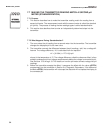
60
8.4 DIAGNOSTIC PARAMETERS
8.4.1 Purpose
This section describes how to do the following:
1. change the standardization or reference offset,
2. enable and disable sensor diagnostics,
3. enable and disable glass impedance temperature compensation,
4. set the high and low warning and failure limits for the glass electrode.
5. set the high and low warning and failure limits for the reference electrode.
8.4.2 Definitions
1. STANDARDIZATION (REFERENCE) OFFSET. The transmitter reading can be changed to match the reading of a sec-
ond pH meter. If the difference (converted to millivolts) between the transmitter reading and the desired value exceeds
the programmed limit, the transmitter will not accept the new reading. To estimate the millivolt difference, multiply the
pH difference by 60. Refer to Section 7.6, Manual Calibration, for additional information. The standardization offset is
also the absolute value of the actual cell voltage in pH 7 buffer. For certain types of non-glass pH electrodes, the off-
set in pH 7 buffer may be as great as 800 mV. To accommodate non-glass electrodes, the offset must be changed from
the default value of 60 millivolts.
2. GLASS IMPEDANCE TEMPERATURE COMPENSATION. The impedance of the glass electrode changes with tem-
perature. For changes in glass impedance to be a useful indicator of electrode condition, the measurement must be
corrected to a reference temperature.
3. WARNING AND FAILURE LIMITS FOR THE GLASS ELECTRODE. Warning tells the user that the glass electrode
impedance is approaching the failure limit. Low and high warning and failure limits are programmable. Low imped-
ance means the glass electrode has cracked and is no longer functioning. High impedance often means the elec-
trode is aging and may soon need replacement. High glass impedance may also mean the electrode is not immersed
in the liquid stream. Figure 8-1 shows suggested settings for glass impedance warning and failure limits.
MODEL 3081 pH/ORP SECTION 8.0
PROGRAMMING FOR pH MEASUREMENTS
FIGURE 8-1. Suggested Glass Impedance Warning and Failure Limits
Typical glass impedance is about 100 megohms at 25°C. A broken electrode has
an impedance of 10 megohms or less. A glass impedance greater than 1000
megohms suggests the electrode is nearing the end of its service life. High imped-
ance may also mean the electrode is not immersed in the process liquid.


















